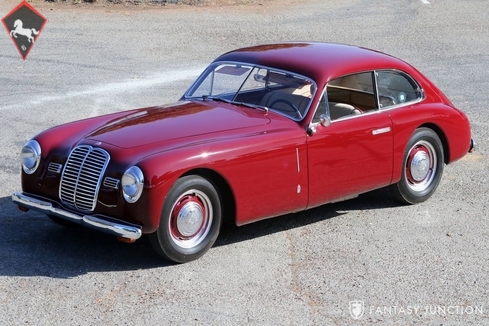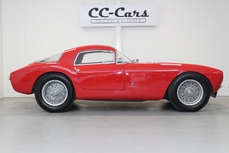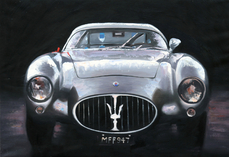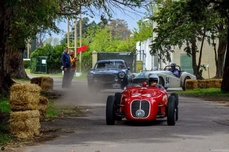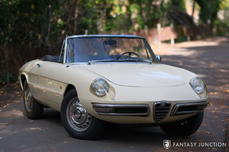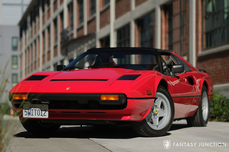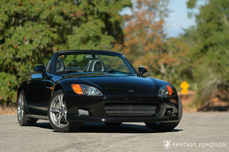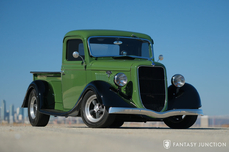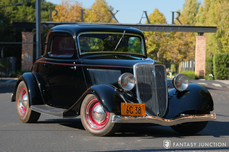Maserati A6 1488cc Single Overhead Cam 6-Cylinder 1949
General description :
1949 Maserati A6 1500 Coupe
s/n 059 Engine no. 059
Dark Red with Red and Tan Interior
Founded in Bologna, Italy, in 1914, by Alfieri Maserati and his brothers Ettore and Ernesto, their humble skills were first offered as specialists for Isotta Fraschini, preparing their cars for road races. However, it was soon evident that Maserati was destined to build the Maserati name crafting their own racecars. The Maserati brothers were not only dedicated enthusiasts, but they were also passionate artisans and engineers – a necessary combination in order to yield fantastic performance cars, especially for premier clientele. This blend of art and engineering, a feature of Italian culture, is embodied in much of their fashion, food, and music, as well as in the fast-growing world of automobile manufacturing. Soon after inception, Maserati was building some of the finest racecars and many of the finest road cars. The often-underfunded company also competed handsomely against giants of industry, building Grand Prix cars, and winning world racing titles, including a rare win at the Indy 500.
After the second world war, Maserati was not only able to survive, but they realized their future was dependent on building cars with an emphasis on dual-purpose – cars capable of top-level performance, and also beautifully appointed for street use. As technology improved and wealthy customers demanded both performance and luxury, Maserati enjoyed a robust following in both motorsports and on the showroom floor. The first of these road models was the A6 1500, which made its debut at the 1947 Geneva Salon. Upon review by the press, the beautifully crafted light-alloy Pinin Farina body was lauded by many to be among the most beautiful cars ever designed. In addition to the beauty, the A6 1500 was also innovative in that it was among the first to feature a smooth, integrated hood and fender design, leading back to a dramatic clean fastback rear with minimal chrome trim, hidden door handles, and a wide but delicately trimmed grill. All of these ideas are considered classic today, but in 1947, this design was truly revolutionary.
Under the hood, engineering followed the path of excellence, where the remarkable 1,488cc single overhead-camshaft six-cylinder engine utilized aluminum and magnesium castings along with a single Weber carburetor, coupled to a four-speed manual gearbox. The ladder frame chassis featured double wishbone front suspension, similar to Maserati racecars, while the coil-sprung live-axle rear suspension balanced out the rear drive platform, yielding a lovely combination of performance and grace; a union that would herald many future Maseratis for years to come.
This beautiful A6 1500 is chassis number 059, the ninth car of just 61 cars in the series produced from 1947-1951 and the only Pinin Farina Berlinetta assembled at the factory on a long wheelbase chassis. Although all the cars constructed in this series would be assembled on a standard chassis, and a long wheelbase chassis had been used in two cabriolet versions of the A6 1500 (chassis number 057 and 075), this is the only Pinin Farina Berlinetta known to have been constructed on a long wheel base chassis. Delivered new in July 1949, the car was configured at the factory with Berlinetta coachwork and finished in dark red Amaterro color.
059 has been researched and documented by renowned Maserati historian Adolfo Orsi. Mr. Orsi confirms the first owner as Mr. Americo Giol, a resident of San Polo di Piave, Italy. Though the duration of his ownership has yet to be confirmed by further registrations, it is known that his brother must have been duly impressed as Vittirio Giol soon became the first owner of chassis no. 078, also a Pinin Farina Berlinetta, constructed later in the series production. Orsi further notes that the car was next imported to the US and then to the UK sometime in the 1970s, eventually returning to Italy in 1993. By the late 90s, the car is known to have been sympathetically restored and subsequently purchased in 2000 by a Japanese collector. In 2003 this A6 1500 was entered and participated in the legendary Mille Miglia event, La Festa Mille Miglia. By 2010, this A6 1500 finds a new owner who then offers it on auction in 2015 at the Quail Lodge during the famed Carmel weekend and concours events. The current owner has continued to maintain the car to high standards, including recent detailed review and mechanical sorting by Epifani restorations.
Today this wonderful car truly presents the elegance of design and engineering that have defined Maseratis. It is important to recall that this car was well ahead of Ferrari in every aspect as Maserati was already in production with the A6 1500 while Ferrari was simply a fledgling venture. Here in every respect the level individualized artistry and performance can be seen in the coachwork and mechanical specifications, further affirming Maserati as leaders of Italian craftsmanship, and pioneers of modern design and engineering. The older restoration while still very handsome has mellowed nicely in the ensuing years, and is both a testimony to the quality and the degree of preservation first offered as an original matching numbers car prior to restoration, but also to upholding the finest in restoration artisanship even in recent years.
The exterior of this A6 has been finished to a high level still showing excellent paint and panel fit. The paint has settled in a bit over the years but still retains a high gloss throughout, with minor surface scratches and light marks from road use. Doors open and shut smoothly, as does the hood and trunk. Brightwork throughout the exterior has been polished and finely detailed to complement the deep red paint. Handsome design elements lightly decorate the exterior including beautifully sculpted recessed door handles, elegantly shaped grille and vent details, and exquisite headlight trim that brightens the fascia while elongating the gently sweeping fender lines. The clean lines of the dark red body are contrasted by the purposeful body colored solid wheels, accented with brightwork trim and center caps embossed with the Maserati name. Both front fenders beautifully stretch forward of the cowl in the one-of-a-kind long wheelbase configuration, proudly flanked by the Pinin Farina coachbuilder’s badge. Even the delicately garnished glass elegantly contributes to the perfect proportions of this dynamic car.
The bold and elegant exterior is further enhanced by the art-deco influenced interior. Opening the door via the lever actuated flush door handle, the large door swings away offering easy ingress into the comfortable seats. Once inside, the expansive glass and light pillar work offer exceptional views around the entire perimeter of the car. The door panels and seats are covered in contrasting tan corded fabric accented by red piping and deep red carpeting. Matching body colored interior trim with elegant deco-inspired chrome handles and dash details further convey the quality of the design. The dashboard is a wonderful display of instrumentation and indicators, highlighted by the steering wheel, itself a work of art. Instruments and some trim are showing signs of patina, but otherwise, the overall visual condition of the dash and instruments is cohesive and refined. Other charming interior features further include a jewel-like ash tray lid, glovebox door clock, and Maserati trident embossed clutch and brake pedals. All components are beautifully designed and faithfully restored, with some of the fabric areas of the rear seat still covered by protective clear plastic.
Under the hood, the car presents well, with excellent workmanship and authenticity to the period, all performed to accurate standards on the matching numbers engine. The hoses, fittings, and various components are faithfully restored, but exhibit some signs of age since restoration. The engine compartment generally shows an even patina throughout, still proudly conveying the history and integrity of the original specifications with details like fabric wrapped lacquered wires, a warmly hued carburetor, and gently toned aluminum castings. The underside of the car has been properly restored, and displays evidence of use in keeping with the general condition of a quality older restoration has mellowed over time.
The car starts easily and idles smoothly once warmed up. The clutch is easily engaged, and the gearbox is representative of a car of this era. Seating position is good with plenty of room even for taller occupants. There is easy visibility over the long hood and the steering quitee good even at slower speeds. The four-speed gearbox is well suited to the car, while the ride is reasonably good in large part due to the rear coil spring suspension. The long wheelbase adds an extra touch of comfort especially at higher speeds. Given the era of construction, especially when compared with other vehicles of the period, the ride comfort and performance feel far ahead of the competition. The overall driving impression is elegant, spirited, and comfortable, with engaging mechanical sounds and delightful interior features accompanying you through even the most mundane drives. We would however recommend a major mechanical service prior to long distance rally use.
This beautifully appointed Maserati A6 1500 is accompanied by a Maserati service manual, and copies of numerous factory documents, early photos and previous registrations as assembled by Maserati expert and premier historian Adolfo Orsi.
Early Maseratis rarely come to market, especially those with documented provenance and made in small quantities. In the case of this car, elegance and performance are unified in captivating harmony in a car that would be welcomed for entry in the Mille Miglia Storica, California Mille, and numerous other events as well as top level concours d’Elegances all over the world. This historically significant Maserati is ready for the next fortunate enthusiast to enjoy as a fine example of Italian motoring excellence, exactly as intended when first constructed by Maserati and expertly crafted by Pinin Farina.
1949 Maserati A6 1488cc Single Overhead Cam 6-Cylinder is listed for sale on ClassicDigest in California by Fantasy Junction for $549500.
Car Facts
Car type : Car Make : Maserati Model : A6 Model Version : 1488cc Single Overhead Cam 6-Cylinder Engine size : 1.5 Model Year : 1949 Location : Emeryville Vehicle Registration : Normal
549500 $
Seller Information
Fantasy Junction
Fantasy Junction
+1 510 653 7555
Fantasy Junction
+1 510 653 7555
People who viewed this Maserati A6 also viewed similar Maserati listed at ClassicDigest
Other cars listed for sale by this dealer
About Maserati
Maserati, the epitome of Italy's finest traditional luxury sports cars. Let's dive into the captivating narrative of Maserati's storied history, shall we?Act 1: The Roaring Twenties
In the heart of Bologna, Italy, Maserati was born in 1914, founded by the Maserati brothers. The roaring twenties saw Maserati establishing itself as a force in racing, capturing hearts with its precision engineering and sleek designs.
Act 2: The Trident's Triumphs
The iconic Trident logo emerged in the 1920s, symbolizing Maserati's dominance in the racing world. Models like the Tipo 26 and the 250F graced the tracks, with the latter securing Juan Manuel Fangio's Formula One World Championship in 1957.
Act 3: The Road Cars Roar (1960s-1980s)
Maserati transitioned from racetracks to the streets, introducing luxurious grand tourers. The Ghibli, a name evoking the desert wind, and the stunning Bora and Merak, with their mid-engine designs, became symbols of automotive elegance.
Production Numbers:
Ghibli (1967-1973): Approximately 1,170 units.
Bora (1971-1978): Around 524 units.
Merak (1972-1983): Approximately 1,830 units.
Act 4: Turbulence and Triumphs
The '80s brought challenges, but Maserati persisted. The Biturbo series aimed to bring the brand to a broader audience, blending performance and luxury. Amid ownership changes, Maserati's spirit endured.
Production Numbers (Biturbo Series):
Biturbo (1981-1994): Over 38,000 units.
Finale: Modern Elegance and Power
Entering the 21st century, Maserati merged tradition with modernity. The Quattroporte, GranTurismo, and Levante continued the legacy, blending Italian craftsmanship with cutting-edge technology.
Maserati, with its timeless Trident emblem, stands as a testament to Italian passion for both racing and luxurious craftsmanship. Through triumphs and tribulations, Maserati has etched its name in the annals of automotive history as a symbol of style, performance, and the pursuit of perfection. See also BiTurbo restoration story: https://www.classicdigest.com/readers-stories/Andreas/713
